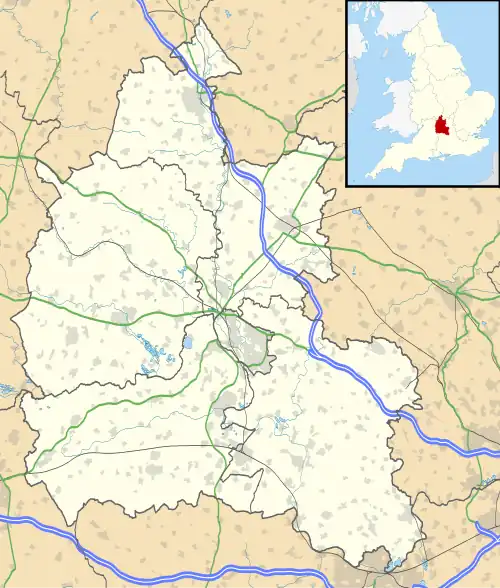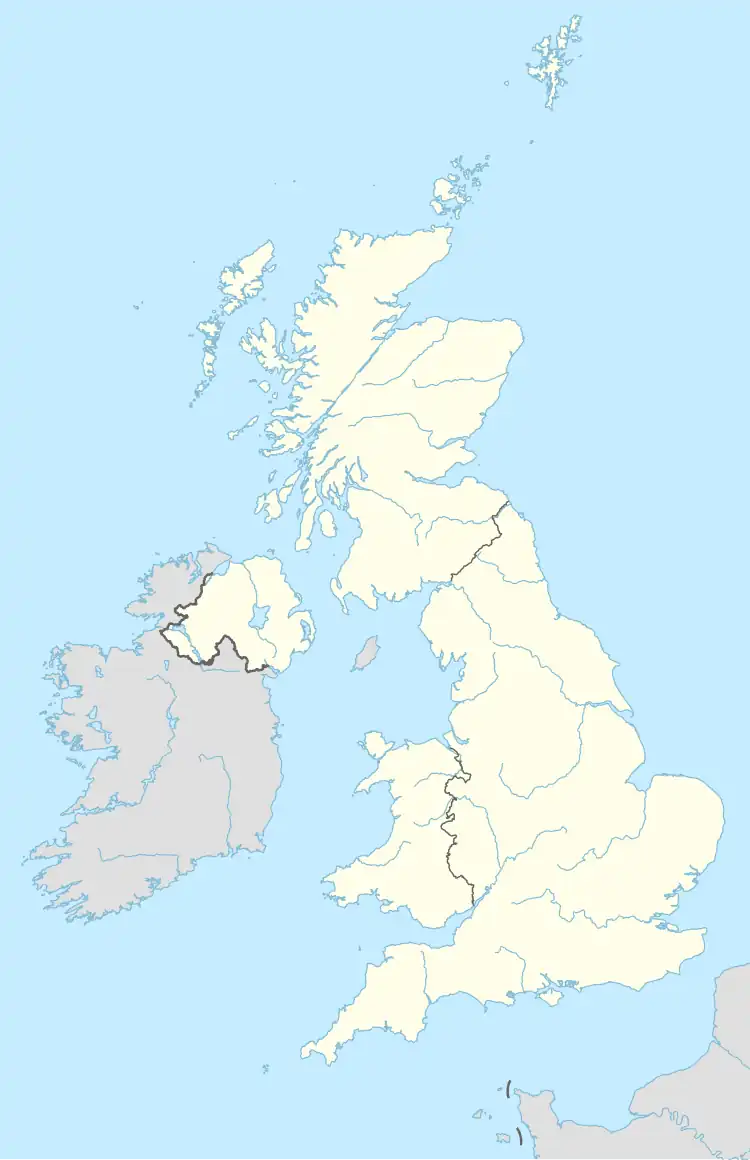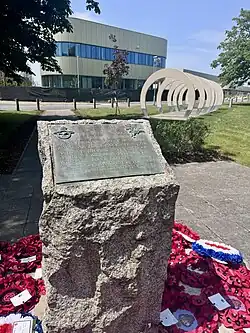RAF Harwell
RAF Harwell | |||||||||||
|---|---|---|---|---|---|---|---|---|---|---|---|
| Harwell, Oxfordshire in England | |||||||||||
 A Short Stirling of No. 295 Squadron RAF, taking off from RAF Harwell towing an Airspeed Horsa glider, 17 September 1944. This was one of 25 Stirling/Horsa combinations which carried the Headquarters of I Airborne Corps to landing zones near Groesbeek, Nijmegen as part of Operation Market Garden | |||||||||||
| Site information | |||||||||||
| Type | Royal Air Force station | ||||||||||
| Code | HW[1] | ||||||||||
| Owner | Air Ministry | ||||||||||
| Operator | Royal Air Force | ||||||||||
| Controlled by | RAF Bomber Command 1937-44 & 1945 * No. 2 Group RAF * No. 6 (T) Group RAF * No. 91 (OTU) Group RAF RAF Fighter Command 1944-45 * No. 12 Group RAF * No. 38 Group RAF | ||||||||||
| Location | |||||||||||
 RAF Harwell Shown within Oxfordshire  RAF Harwell RAF Harwell (the United Kingdom) | |||||||||||
| Coordinates | 51°34′30″N 1°18′43″W / 51.575°N 1.312°W | ||||||||||
| Site history | |||||||||||
| Built | 1914 & 1936/37 | ||||||||||
| Built by | John Laing & Son Ltd | ||||||||||
| In use | 1914-?? February 1937 - 1945 | ||||||||||
| Battles/wars | European theatre of World War II | ||||||||||
| Airfield information | |||||||||||
| Elevation | 117 metres (384 ft)[1] AMSL | ||||||||||
| |||||||||||
Royal Air Force Harwell or more simply RAF Harwell is a former Royal Air Force station, near the village of Harwell, located 4.8 miles (7.7 km) south east of Wantage, Oxfordshire and 17 miles (27 km) north west of Reading, Berkshire, England.
The site is now the Harwell Science and Innovation Campus which includes the Rutherford Appleton Laboratory.
History
The airfield was built by John Laing & Son Ltd at the junction of three parishes in 1935.[2] The bulk lay within Chilton parish; about a third was in East Hendred; and the smallest portion was in Harwell. The first Commanding Officer, upon being asked what the name of the new airfield should be, responded that it should be named after the parish in which his house lay – and this happened to be Harwell.[3]
Between 1938 and 1940 it was a development site of a prototype Royal Aircraft Establishment Mark III Catapult, whose intention was to enable take-offs using shorter runways and so the planes could be loaded with more fuel. Although technical problems caused its abandonment without ever launching an aircraft, it proved to be a precursor to Catapult Armed Merchant ships.[4]
No. 105 Squadron RAF was reformed on 12 April 1937 at Harwell from 'B' Flight of 18 Squadron as a day bomber squadron. Its first equipment was the biplane Hawker Audax while it awaited delivery of the more modern monoplane Fairey Battle. The Battles arrived in August 1937 and 105 Squadron was one of the first to be operational on the type.
At the start of the Second World War in September 1939, as part of the Advanced Air Striking Force, No. 72 (Bomber) Wing RAF and 105 Squadron moved to France, initially on reconnaissance missions along the France-German border. From its opening in February 1937 until March 1944, various bomber squadrons were stationed at the airfield. On the outbreak of the Second World War, 105 Squadron was dispatched to France. Later the station was used for leaflet missions over France using Vickers Wellington bombers, later bombing raids on Bremen, Cologne and Essen. There were numerous Luftwaffe raids on the airfield from August 1940 until September 1941. The original grass field was replaced with concrete runways between July and November 1941.[5]
The following squadrons were located at Harwell:
- No. 75 (New Zealand) Squadron RAF (September 1939-April 1940)[6]
- No. 105 Squadron RAF[7]
- No. 107 Squadron RAF[8]
- No. 148 Squadron RAF[9]
- No. 215 Squadron RAF[10]
- No. 226 Squadron RAF[11]
- No. 295 Squadron RAF[12]
The following units were also here at some point:[13]
- No. 3 Group Pool
- No. 13 OTU
- No. 15 OTU
- No. 91 Group Servicing Section
- No. 2741 Squadron RAF Regiment
- No. 2766 Squadron RAF Regiment
- Engine Control Instructional Flight RAF
- Ferry Training and Despatch Flight RAF
- Transport Command Development Unit RAF
No. 1443 (Ferry Training) Flight RAF, which was only ever located at Harwell, became No. 310 Ferry Training Unit on 30 April 1943.[14] No. 310 FTU was later merged into No. 311 FTU, located elsewhere.
In March 1944, the station was reallocated to 38 Group, flying the Airborne Forces, where it mainly operated tug aircraft towing Airspeed Horsas which were used in a number of operations. No. 570 Squadron RAF[15], flying glider towing aircraft, arrived on 14 March 1944, staying until 7 October 1944. Operations included carrying the first glider-borne troops into Normandy to secure vital strategic positions in advance of the main landings on D-Day. A memorial to the men who flew from RAF Harwell who were killed on this operation now exists at one edge of the old airfield site, and a memorial service is held there annually. The airfield was also used briefly for Special Operations Executive (SOE) operations between July and September 1944.
Closure and subsequent use

The RAF station was closed at the end of 1945 and the site transferred to the Ministry of Supply on 1 January 1946, where it became the Atomic Energy Research Establishment. Over the years that reduced in scale and other science-based research moved in, such as the Rutherford Appleton Laboratory in 1957. In 1995 the former RAF prewar NCO married quarters were sold to the Welbeck Estate Group by UKAEA, for onward redevelopment as civilian housing. The station site is now home to the Harwell Science and Innovation Campus.
References
Citations
- ^ a b Falconer 2012, p. 105.
- ^ Ritchie, p. 91
- ^ Hance, Nick (November 2006). Harwell: The Enigma Revealed (1st ed.). Buckland, Oxfordshire: Enhance Publishing. pp. 13–14. ISBN 0-9553055-0-0.
- ^ "World War Two experimental catapult unearthed by archaeologists". BBC. 11 October 2023. Retrieved 12 October 2023.
- ^ "RAF Harwell airfield". Control Towers. Retrieved 7 June 2013.
- ^ Jefford 1988, p. 48.
- ^ Jefford 1988, p. 54.
- ^ Jefford 1988, p. 55.
- ^ Jefford 1988, p. 62.
- ^ Jefford 1988, p. 71.
- ^ Jefford 1988, p. 73.
- ^ Jefford 1988, p. 84.
- ^ "Harwell (Chilton)". Airfields of Britain Conservation Trust. Retrieved 21 April 2022.
- ^ Lake, Alan (1999). Flying units of the RAF. Shrewsbury,UK: Airlife. p. 89. ISBN 1-84037-086-6.
- ^ Jefford 1988, p. 97.
- ^ "D-Day tribute sculpture unveiled at former RAF Harwell airbase". BBC News. 6 June 2025. Retrieved 13 June 2025.
Bibliography
- Ritchie, Berry (1997). The Good Builder: The John Laing Story. James & James.
- Falconer, Jonathan (2012). RAF Airfields of World War 2. UK: Ian Allan Publishing. ISBN 978-1-85780-349-5.
- Jefford, C.G. (1988). RAF Squadrons. A comprehensive record of the movement and equipment of all RAF squadrons and their antecedents since 1912. Shrewsbury: Airlife. ISBN 1-85310-053-6.